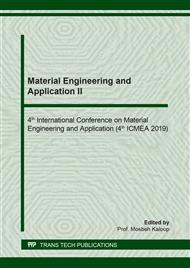p.335
p.340
p.346
p.355
p.363
p.369
p.375
p.381
p.387
Surface Roughness Prediction Based on Acoustic Emission Signals in High-Precision Diamond Turning of Rapidly Solidified Optical Aluminum Grade (RSA443)
Abstract:
Acoustic emission signal-based prediction of surface roughness has been utilized widely, yet little work has been done in this regard on RSA443. This paper seeks to study the correlation between acoustic emission (AE) signal parameters and surface roughness. Estimation of surface roughness using AE signal parameters and subsequent examination of the influence of AE signal parameters (root mean square, peak rate and prominent frequency) on the accuracy of the RSM model in surface roughness prediction are carried out. The experiment is designed using the Taguchi L9 orthogonal array to minimize the number of experiments. Emitted acoustic signals are captured using a Piezotron sensor. Three RSM models are formulated and compared in this study: a model that uses only critical machining parameters (cutting speed, depth of cut and feed rate), a model that uses only AE signal parameters (root mean square, peak rate and prominent frequency) and a model that uses both critical machining parameters and AE signal parameters. An assessment based on the models’ mean absolute percentage error (MAPE) is made to see if AE signal parameters have any contribution towards surface roughness prediction accuracy. The order of parameter significance in the most accurate model is investigated in this paper. The mean absolute percentage error results for the models indicate that the model in which AE signal parameters are utilized in conjunction with critical machining parameters has the highest prediction accuracy of 97.32%. The model that utilizes only critical machining parameters has a prediction accuracy of 96.35% while the one that utilizes only AE signal parameters has a prediction accuracy of 84.43%. It is observed that the order of parameter significance from the most to the least significant is as follows: feed rate, cutting speed, peak rate, AErms, depth of cut and prominent frequency.
Info:
Periodical:
Pages:
363-368
Citation:
Online since:
May 2020
Authors:
Price:
Сopyright:
© 2020 Trans Tech Publications Ltd. All Rights Reserved
Share:
Citation:


